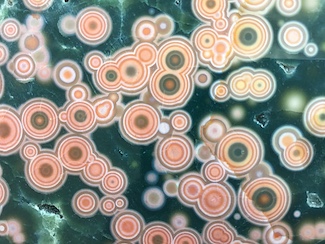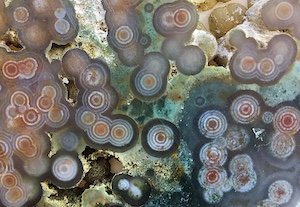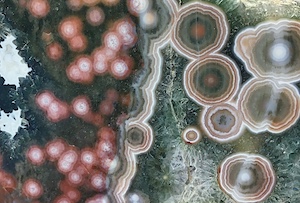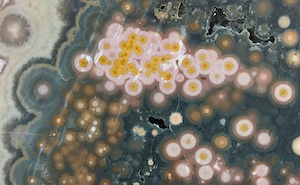Questions and Answers on Ocean Jasper
Q: What is Ocean Jasper and where does it come from?
A: Ocean Jasper is technically a "spherulitic chalcedony", an orbicular rock composed of the quartz variety
chalcedony with spherulitic formations. High grade varieties were originally discovered in NW Madagascar
in coastal and inland areas.
Q: I've heard Ocean Jasper described as a "silicified rhyolite" or "spherulitic rhyolite". Are these correct descriptions?
A: Short answer: No. Long answer: Rhyolite is igneous rock formed from magma rich in silica that is
extruded from a volcanic vent to cool quickly on the surface rather than slowly in the subsurface: the
extrusive equivalent of intrusive granite. A wide variety of Ocean Jasper specimens have been characterized
by laboratory testing as quartz chalcedony with trace mineral content, which I provided on Mindat in a
first ever characterization study, found HERE.
Though extrusive rhyolite may have been a host vessel for
the complex fluid precursor to the mined hardened specimens we see today, such specimens are not
themselves "rhyolite". A possible example of a spherulitic rhyolite is Rainforest Jasper from Australia,
however there exists no characterization studies of these specimens to classify them as such.
"Silicified rhyolite" implies some sort of change to a rhyolitic matrix via "silicification", or an
infusion of a silica solution into a rhyolitic matrix, so as to create the complex structures seen in
Ocean Jasper. There exists no evidence for this.
Q: Is Ocean Jasper a metamorphic rock?
A: Short Answer: No. Long answer: The definition of "metamorphic rock" given on Mindat is:
"Any rock derived from preexisting rocks by mineralogical, chemical, and/or structural changes,
essentially in the solid state, in response to marked changes in temperature, pressure, shearing stress,
and chemical environment, generally at depth in the Earth's crust." Metamorphic rock is considerably
altered in its original solid state to another distinguishable state. Typical examples are heavily
weathered and altered rock, such as schist, tektite, granitic gneiss, solid rock altered under
considerable pressure or temperature differentials. Clearly this does not apply to Ocean Jasper
("spherulitic chalcedony"). Yes, relatively non-invasive weathering has been observed, but not
the type of changes observed in metamorphic rock. The fine/refined features in Ocean Jasper are
from a relatively pristine original formation, as described in examples of zoning and spherulitic
banding HERE.
Q: What is the source for the complex transitions seen in Ocean Jasper specimens?
A: Numerous complex transitions occur in both the matrix and spherulite types in Ocean Jasper.
The basic drivers for these complex transitions are nonequilibrium dynamic processes, such as
reaction-diffusion, that lead to zoning and spherulitic banding,
and self-organized pattern formation.
Q: What is the source for the colors seen in Ocean Jasper specimens?
A: Predominantly the source is iron oxide/hydroxide particulates that precipitate out of solution
into the gel-sol formations of the matrix and intertwined matrix/spherulite growth. Further discussion
is found HERE.
Q: Does Ocean Jasper contain toxic realgar or orpiment?
A: Not that I am aware of. Realgar and orpiment are both arsenic sulfides. In the characterization
studies I published on Mindat, none of the samples had any arsenic present in the SEM/EDX measurements,
and a few of these samples were reddish, primarily from red iron mineral content.
Q: I'm seeing a great deal of material being sold online as Ocean Jasper, is any of it authentic?
A: A significant amount of material sold online today as "Ocean Jasper" is not authentic. What does
"authentic" mean? It means spherulitic chalcedony sourced exclusively from Madagascar, and then exclusively
from two regions, Marovato (NW coastal) and Kabamby (NW inland). I discuss in my book additional history
and statistics of mined Ocean Jasper, particularly "old stock", which refers to high grade material
mined prior to 2007, though "old stock" is now being applied to later mined deposits, from 2013-present.
Since it is unclear where exactly these later deposits were mined and the deposit volumes, relative to
earlier pre-2007 mined deposits, I only refer to specimens from pre-2007 mined deposits as "old stock".
The issue of provenance of specimens is significant, though high grade "old stock" specimens are easily
recognizable to collectors from newer mined material, and valuable due to scarcity.
Q: What about "Ocean Jasper" from Indonesia?
A: The Indonesian orbicular material does indeed have similarities with a subset of Ocean Jasper,
namely multiple-ringed spherulites and spherulite tails, vivid colors and translucency. A few example
specimens are shown HERE.
There is a concerted effort from dealers in Indonesia to brand their orbicular
rock "Ocean Jasper", even though in the last 10 years the material has been sold by U.S. dealers under
the name "River Jasper". Despite the similarities, this material is easily distinguishable from Ocean
Jasper, as the Indonesian spherulites have a characteristic homogeneous oblate spherulite that is
limited to a much smaller size, typically 2-3mm, and the zoning and pattern formations are far less
complex or heterogenous.
Q: What about the ethical mining issues surrounding minerals, rocks and gems mined in and exported from Madagascar?
A: There are several ethical issues with material mined in Madagascar. First, Madagascar is
still a very poor country, with a 2020 per capita GDP of $495 (USD). A majority of residents live below the
poverty line. Fair trade is clearly a problem, with workers making significantly low
wages, while exported goods sell at a premium. Second, mining practices in Madagascar include strip mining
for a variety of material (e.g. Ocean Jasper) without a requirement for geological documentation or
preservation of natural history. It is unfortunate that the major find of high grade "old stock" Ocean Jasper
1999-2006 did not accompany a geological survey, in-situ documentation of specimens, classification of
the multitude of varieties, etc. before removal. This practice continues to the present, where newer finds are
likewise undocumented. Such a practice is unwelcome to the collector community. Collectors value provenance,
and this includes documentation of where and how a specimen is mined, along with in-situ photos and scales.
Collectors also value fair trade.
Q: Where can I find out more about Ocean Jasper, formation theories and open geological questions?
A: The ferrous-silica formation model I describe here was originally proposed in the 2019 published book
Ocean Jasper: A Natural Wonder and a Geological Mystery.
I encourage readers who want to know more
to purchase the book, as it includes not only an explanation of this model, but a description of the
mining history and unknown geological information, a grading scale of Ocean Jasper based on complexity,
and a comparison of "spherulitic chalcedony" with conventional agates and orbicular jaspers.
All author proceeds are donated to research studies, and to the upkeep of this website as a living
document for specimen photos and dissemination of research information.



